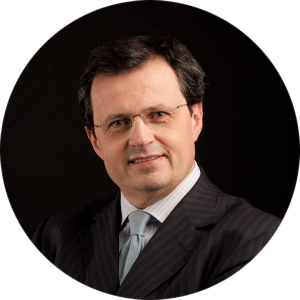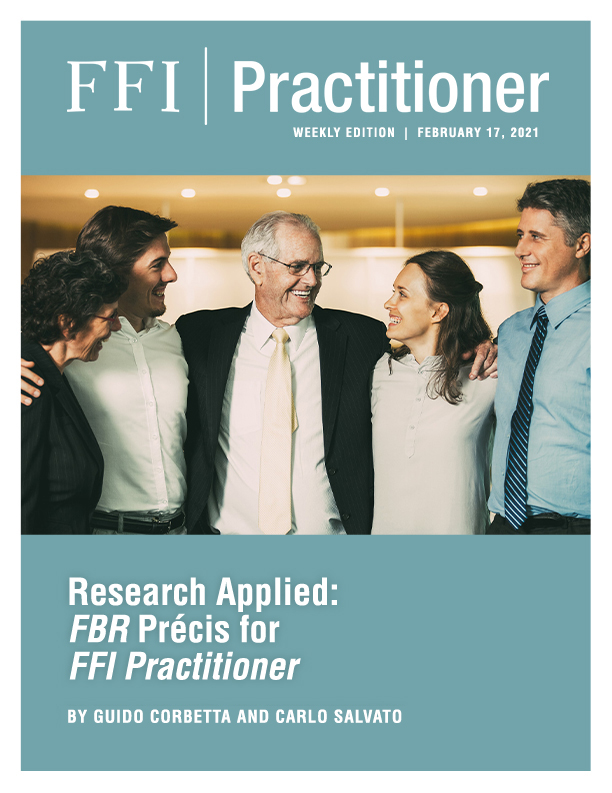
Introduction
Family values and family business behavior: The missing link
This study investigates the influence of values on the behavior of family firms. When asked what makes their company distinct, members of an entrepreneurial family often answer, “Our values.” Similarly, many advisors are convinced that a successful consulting process starts with family members jointly answering this question: “What are the core values that you share as a family?” Yet, there is surprisingly limited rigorous research on what these values are and how they shape family business behavior and performance. This study tries to fill that void by investigating the values of owner managers in 1,003 German family businesses.
Family values and the five dimensions of Socioemotional Wealth (SEW)
To understand how family members’ values affect family business behavior, the authors investigate the influence of values on SEW. SEW is a framework that summarizes unique behavior of family businesses along five dimensions, called the FIBER dimensions outlined below.
I) Identification of family members with the firm
B) Presence of strong binding social ties both within and outside the family business
E) Intense emotional attachment of family members to the business entity
R) Striving for constant renewal of family bonds to the firm through multi-generational succession
Findings
To understand how family values affect specific family business behavior and SEW, the authors investigate the relationship between the four higher-order values described in Schwartz’s classification of values,1 and the five FIBER dimensions. Each one of the Schwartz four “higher-order” values comprises two or three more specific “distinctive values.” The four higher-order values are openness to change (determined by self-direction, stimulation, and hedonism), self-enhancement (achievement and power), self-transcendence (universalism and benevolence), and conservation (conformity, tradition, and security).
“Openness to change” and FIBER
Openness to change of owner-managers has a strong positive effect on family control (F) and influence (I). Since it is grounded in independence and freedom of choice, it is not surprising that “openness to change” has a positive effect on the willingness to keep control of the business under the family, resulting in strong control of, and identification with, one’s actions.
“Self-enhancement” and FIBER
Self-enhancement of owner-managers has a significant positive effect on the FIBER dimensions’ identification of family members with the firm (I). Individuals who are high in self-enhancement typically have high needs for personal success, reputation, status differentiation, prestige, and dominance over others. Therefore, they will tend to identify more with their family business, which is the main source of their power and reputation.
“Self-transcendence” and FIBER
Self-transcendence of owner-managers also has significant positive effects on the FIBER dimensions of binding social ties (B) and the emotional attachment of family members (E). This relationship is a logical outcome of the study, given that self-transcendence has to do with prioritizing the interests of others — be they close relatives (thus the positive impact on E) or external stakeholders (thus the positive impact on B, particularly if related to external networks).
“Conservation” and FIBER
Conservation of family business owner-managers has a positive effect on all five FIBER dimensions. This result is also not surprising because, since SEW captures the willingness of the entrepreneurial family to keep a strong relationship with the business and, thus, family control (F), identification (I), binding ties (B), emotional attachment (E), and renewal (R).
Implications
Implications for advisors
- Advisors can consider introducing activities aimed at identifying the values shared by their clients by creating a short summary of this article’s results, which reports the extent to which Schwartz’s values are related to the FIBER dimensions. This type of introduction is helpful when clients perceive working on shared values as a “soft” topic devoid of practical value and tangible implications.
- Advisors can consider asking their clients to individually complete Schwartz’s value questionnaire.2 Mapping their clients’ values allows advisors to understand: (a) how close or far family members are in terms of values, before starting values-related activities; (b) the strength of each one of the five FIBER dimensions of SEW; and (c) the overall willingness of the family to preserve socioemotional value.
- Advisors can plan activities aimed at “balancing” family values in the desired direction. For example, if key family decision-makers (or, on average, the whole family) lean excessively towards conservation (security, conformity, tradition), strategic renewal and entrepreneurial projects may be significantly hampered. With the help of experts in human resource management, advisors can plan preliminary activities aimed at strengthening openness to change (self-direction, stimulation, hedonism) of key family members.
Sidebar

Implications for family firms
- Family firms often describe their shared values in public documents and on their websites, with the aim of offering a positive picture to external stakeholders. These descriptions sometimes risk being perceived as window dressing by external stakeholders. To make their values statements more convincing, controlling families, with the assistance of expert external advisors, may be able to describe how specific shared values determine attitudes and behavior more explicitly — taking inspiration from the relations tested by this study.
Implications for applied research
- Family members and advisors seldom describe their values in terms of the four higher order FIBER values or the ten distinctive values of Schwartz’s classification. Applied research projects may can be designed to understand how self-labelled family values, e.g., “In making strategic choices, we deeply value our company history,” map onto Schwartz’ values. For example, testing whether self-labelled values correlated with “stimulation,” “tradition,” or others in Schwartz’s classification.
- Further research can also test the relation between values and behavioral attitudes by using a wider variety of tools that classify values.3 Researchers may then be able to identify those classifications tools that use concepts and language closer to specific family business contexts – possibly related and/or complementary to Schwartz’s classification.
- Future studies might also try to capture shared family values, e.g., by calculating an average of questionnaire responses from multiple family members, rather than a single family member, and how they shape the five FIBER components of SEW.
References
1Schwartz, S. H. (1992). Universals in the content and structurevof values: Theoretical advances and empirical tests in 20 countries. In Back to the Roots: Applying the Concept of Individual Human Values to Understand Family Firm Behavior. Family Business Review, 34(1), 1-23. https://doi.org/10.1177/0894486520944282. First published online July 29 2020.
2The questionnaire is available online, for example on the website of the University of Cambridge, The Psychometrics Centre (https://discovermyprofile.com/tests).
3Several rigorous classifications can be found online (e.g., https://positivepsychology.com/values-questionnaire/).




